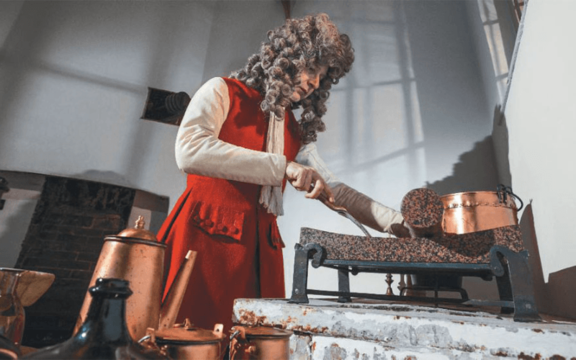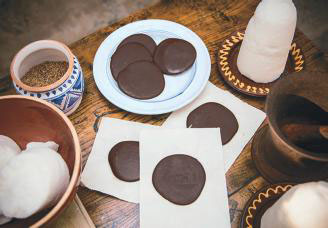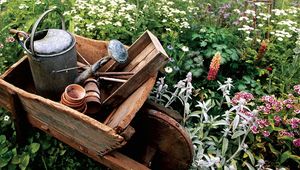
The King’s private chocolate chef, Thomas Tosier, turns out all manner of dishes in the Royal Chocolate KitchenHistoric Royal Palaces
Hidden behind a store room, a complete Georgian confectionery reveals itself.
* Originally published in 2016.
When your palace has 1,600 rooms, you can be forgiven for losing the odd chocolate kitchen. “It’s not so much that we lost it,” protests Marc Meltonville, Hampton Court’s resident food historian, “more that we weren’t looking for it.”
There had been rumors, of course. Most of them started with the Victorians who opened the palace to the public and concocted all sorts of legends. “That’s when most of the ghosts turned up,” says Meltonville. But the Historic Royal Palaces’ archaeological team didn’t really expect a Georgian chocolatier’s workshop to actually fetch up, not least because so many rooms had been demolished over the years and more were lost in a devastating 1986 fire.
Their lucky break came when they found an inventory made on the death of King William III, which mentioned a specific doorway in Fountain Court. On finding a key to the mysterious “Door Eight,” the team discovered miles of steel shelving and a small colony of vases. It was the store room for the annual flower show.
The team cleared the area, intending to re-create a workshop that might have been like the one George I’s personal chocolatier, one Thomas Tosier, would have used. As the rolls of florists’ wire and acres of bunting disappeared, the curators were astonished. “We’d actually found a kitchen,” says Meltonville.
Everything was intact: the charcoal fireplace where the beans would have been roasted, complete with elaborate spit mechanism and smoke-jack operating system, 18th-century shelves and a cupboard where equipment was stored; a brick stove over which the chocolate would have been heated and the original fold-down prep-table, still firmly fixed to the wall.
The world’s sole surviving Georgian Chocolate Kitchen is an even luckier find, as the room just feet away next door was destroyed in the 1986 fire. This, though bad at the time, has proved a blessing, as historians have been able to create an exact replica of Tosier’s realm in the space. Experimental archaeologists can don the full periwig, breeches and frock coat ensemble to work out how kings William III and Georges I and II enjoyed their chocolate. Exotic spices, oils and techniques gleaned from contemporary letters, documents and recipes are all minced into the mélange of tasks that includes roasting, distilling and a lot of grinding.
The public can visit three rooms: the kitchen itself, with a fascinating projected display that informs without annoying; the replica kitchen opposite, where experimental chocolate-making sessions take place; and the room where Tosier garnished his creations ready for presentation. The exquisite serving apparatus has been re-created specially for the project using authentic processes and shards from archaeological digs around the palace to replicate Tosier’s culinary armory.
Of course, the chocolate enjoyed by the monarchs of old has little in common with how we know it today. Cocoa was first introduced in the 16th century and became an immediate hit with the very wealthiest members of society (it was much more expensive than the already astronomically priced coffee or tea), but it was always a beverage. It was dark, spicy and rich, though not as bitter as one might expect. Visitors can discover the differences for themselves.
Specially produced sample flights of chocolate are being served in the Fountain Court Café, including examples from each era. “The King’s Chocolate,” heady, spicy and very dark, dates from 1661 and was Charles II’s tipple. The Georgian version has overtones of cardamom and aniseed and is served with milk. Victorian hot chocolate is much like the recipe we know today and, after the first two, rather sweet. The final taster is a modern, white-chocolate fantasy, tasting of vanilla, raspberry and hot summer evenings.
It is unlikely Hampton Court has yielded all of its secrets yet. Marc Meltonville has his eye on an old engine room a few doors down from the chocolate heaven. He thinks it could be a wine cellar, but until someone finds a key it remains a mystery.

©HISTORIC ROYAL PALACES
Chocolate Sessions
Hampton Court’s Georgian Chocolate Kitchens are open to the public as part of the entry price. Dates and times for live chocolate-making sessions can be found at www.hrp.org.uk.
* Originally published in 2016.





Comments